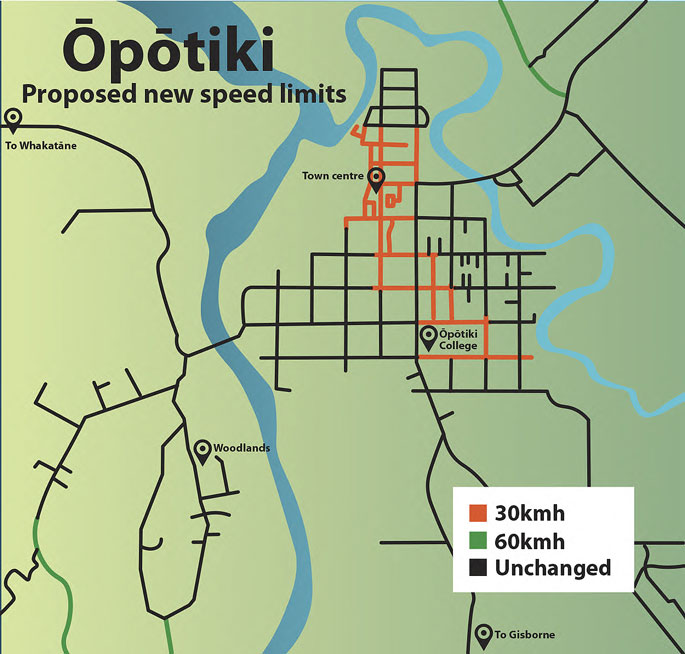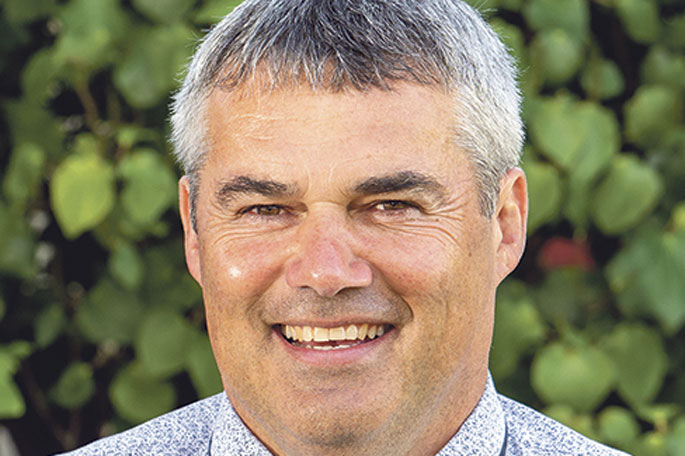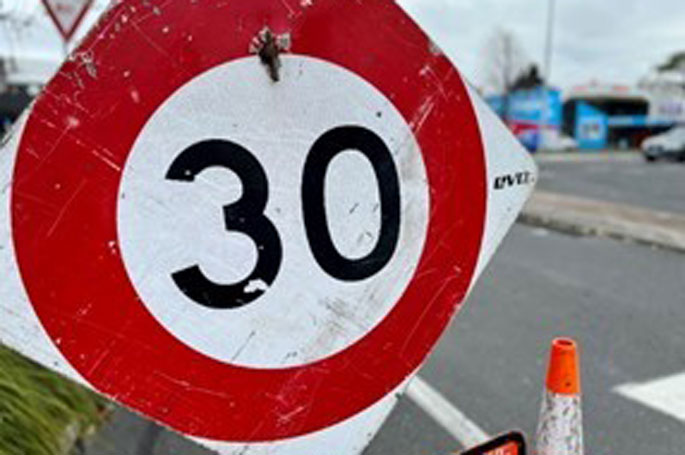After two unsuccessful votes and a flurried phone call to the deputy mayor, Ōpōtiki Mayor David Moore eventually used his casting vote to adopt a speed management plan that will have traffic slowed to 30km/h around parts of the district.
At a council meeting on Tuesday, deputy mayor Shona Browne was absent, due to illness, leaving six elected members to decide whether to adopt the Interim Speed Management Plan.
The plan will see 30km/h areas established on several of the Ōpōtiki township’s high pedestrian activity areas and around schools and preschools and marae throughout the district by the end of June next year.
The plan follows guidance set out in transport agency Waka Kotahi’s Speed Management Guide – Road to Zero edition. The council held early engagement sessions with schools, marae representatives, people who had previously requested speed reductions and iwi representatives who assisted staff to help refine the plan before it was released for a three-week public consultation on July 3.
There were 40 submissions from the public to the proposal, 20 of which were in support, and a further nine partially supporting it.
Eight submissions were opposed, two did not specify and one was rejected due to the use of profanity and content unrelated to the proposal.
 Streets in the Ōpōtiki township that will be changing to 30kmh speed zones before July next year. Beacon file image.
Streets in the Ōpōtiki township that will be changing to 30kmh speed zones before July next year. Beacon file image.
Planning and regulatory group manager Gerard McCormack said there was good support for the plan.
However, councillor Tom Brooks spoke out against blanket 24/7 30km/h limits in favour of flashing electronic variable speed signs around schools.
“No one’s going to argue with the fact that we need to do something around schools with speed. I think permanently (24/7) changing a road to 30kmh is unintelligent. Why would you have a speed limit at 30kmh at 10pm when school’s gone home."
The former police officer also felt it would be unenforceable.
“Any law or rule you put in place is only as good as you can enforce it. If you can’t enforce it, it’s a waste of time. This is not going to be enforced ... I’ve been told by police that even if they had 50 staff they wouldn’t be able to do it.
“If you put up a flashing 40kmh sign and back it up with a speed bump in certain areas, I think that would be more beneficial than a blanket approach,” Mr Brooks said.
 Former police officer, councillor Tom Brooks says the new speed limits will only be as good as Ōpōtiki Police's ability to enforce it.
Former police officer, councillor Tom Brooks says the new speed limits will only be as good as Ōpōtiki Police's ability to enforce it.
Mr McCormack said it was a requirement of central government that they do this and suggested that if they didn’t do it now they might miss out on the 75 percent funding to implement the changes they would receive from Waka Kotahi. He said the electronic variable speed signs would be an extra cost to ratepayers.
The budget for the changes in the plan was $146,000, 25 percent of which was being paid for by the council, the remaining 75 percent funded from Waka Kotahi.
Mr Brooks was keen to go back to Waka Kotahi and ask if they would be prepared to fund the flashing signs and put off adopting the plan until such time as they had a response. However, staff said the council needed an answer that day as timeframes were “pretty tight” in order to align with the next phase of speed management, which was a regional plan covering the whole Bay of Plenty, which would, itself, become part of a national plan.
Councillor Maxie Kemara said the council needed to consider the submissions that were made, with 50 percent of submissions being for the changes and another nine partly supporting it.
Indicating the list of submitters, he said, “I get where Tom’s coming from with the limits being 24/7 with the schools here in town, but I think us, here, as council need to be representing these people.”
Mr Moore and councillor Barry Howe agreed with Mr Kemara.
“We’ve got to listen to our submitters or else they’re not going to submit,” Mr Howe said.
Mr Moore moved that the council adopt the plan as it stood. He, Mr Howe and Mr Kemara voted for this. Mr Brooks and councillors Steve Nelson and Dean Petersen voted against it, splitting the vote three against three.
 Mayor David Moore used his casting vote to adopt the new speed changes.
Mayor David Moore used his casting vote to adopt the new speed changes.
A second motion, to make the speed changes only to areas outside Ōpōtiki township, and leave changes within the town to be set as part of the regional speed management plan, was moved by Mr Brooks.
However, the voting was still split three against three.
After further lengthy discussion, Mr Moore phoned Mrs Browne to ask her which way she would have voted if she had been at the meeting. Mrs Browne said she had read the report the week before and had always intended to vote to adopt the plan.
Mr Moore then made his original motion again and, based on Mrs Browne’s response, used his casting vote to decide the matter in favour of adopting the plan.
Sidebar: Areas affected by Interim Speed Management Plan
As well as areas around schools in town, other 30kmh areas around Ōpōtiki will be the area around Woodland’s School, Ranginui Woodlands Cemetery, Snell Road and Waiōweka Pa Road.
The rest of Woodlands Road between McGregor Road and Grant Road would be 60kmh, along with Dip Road.
Waiōtahe School would have a variable 30kmh speed limit, with the remainder of Gabriels Gully Road being 60kmh.
Along the coast, in Ōmarumutu, parts of Ōmarumutu Road around marae and kura will be 30kmh, in between will be a 50kmh area and south of the kura will be 60kmh, as will Hikurangi Road.
In Maraenui, parts of Maraenui Pa Road near kura and marae will be 30kmh and in Omaio, Omaio Pa Road and Omaio Church Road will be 30kmh.
In Opape, Opape Road will be 50kmh except for 30kmh areas around marae and boat ramp access areas.
In Te Kaha, Copenhagen Loop Road will be reduced to 50kmh.
Public Interest Journalism funded through NZ On Air.




0 comments
Leave a Comment
You must be logged in to make a comment.